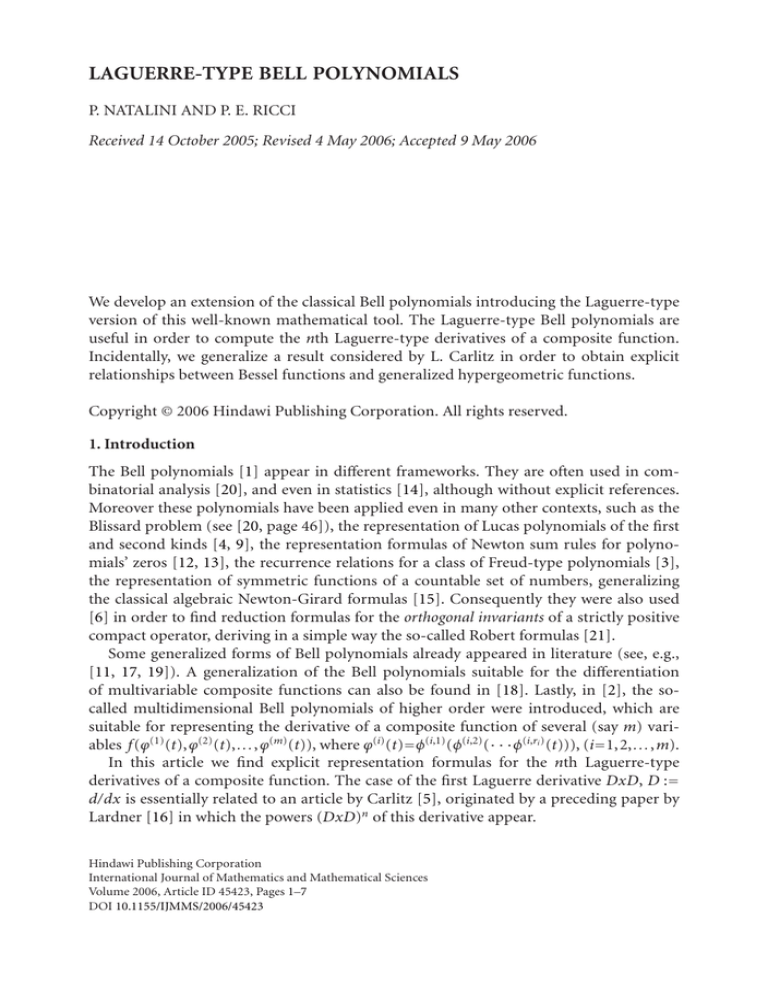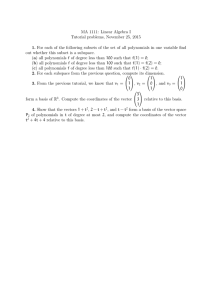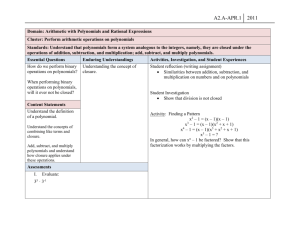
LAGUERRE-TYPE BELL POLYNOMIALS
P. NATALINI AND P. E. RICCI
Received 14 October 2005; Revised 4 May 2006; Accepted 9 May 2006
We develop an extension of the classical Bell polynomials introducing the Laguerre-type
version of this well-known mathematical tool. The Laguerre-type Bell polynomials are
useful in order to compute the nth Laguerre-type derivatives of a composite function.
Incidentally, we generalize a result considered by L. Carlitz in order to obtain explicit
relationships between Bessel functions and generalized hypergeometric functions.
Copyright © 2006 Hindawi Publishing Corporation. All rights reserved.
1. Introduction
The Bell polynomials [1] appear in different frameworks. They are often used in combinatorial analysis [20], and even in statistics [14], although without explicit references.
Moreover these polynomials have been applied even in many other contexts, such as the
Blissard problem (see [20, page 46]), the representation of Lucas polynomials of the first
and second kinds [4, 9], the representation formulas of Newton sum rules for polynomials’ zeros [12, 13], the recurrence relations for a class of Freud-type polynomials [3],
the representation of symmetric functions of a countable set of numbers, generalizing
the classical algebraic Newton-Girard formulas [15]. Consequently they were also used
[6] in order to find reduction formulas for the orthogonal invariants of a strictly positive
compact operator, deriving in a simple way the so-called Robert formulas [21].
Some generalized forms of Bell polynomials already appeared in literature (see, e.g.,
[11, 17, 19]). A generalization of the Bell polynomials suitable for the differentiation
of multivariable composite functions can also be found in [18]. Lastly, in [2], the socalled multidimensional Bell polynomials of higher order were introduced, which are
suitable for representing the derivative of a composite function of several (say m) variables f(ϕ(1) (t),ϕ(2) (t),...,ϕ(m) (t)), where ϕ(i) (t)=φ(i,1) (φ(i,2) (· · ·φ(i,ri ) (t))), (i=1,2,...,m).
In this article we find explicit representation formulas for the nth Laguerre-type
derivatives of a composite function. The case of the first Laguerre derivative DxD, D :=
d/dx is essentially related to an article by Carlitz [5], originated by a preceding paper by
Lardner [16] in which the powers (DxD)n of this derivative appear.
Hindawi Publishing Corporation
International Journal of Mathematics and Mathematical Sciences
Volume 2006, Article ID 45423, Pages 1–7
DOI 10.1155/IJMMS/2006/45423
2
Laguerre-type Bell polynomials
2. Recalling the Bell polynomials
We recall that the Bell polynomials are a classical mathematical tool for representing the
nth derivative of a composite function. In fact by considering the composite function
Φ(t) := f (g(t)) of functions x = g(t) and y = f (x) defined in suitable intervals of the real
axis and n times differentiable with respect to the relevant independent variables and by
using the following notations:
Φh := Dth Φ(t),
fh := Dxh f (x)|x=g(t) ,
gh := Dth g(t),
[ f ,g]n := f1 ,g1 ; f2 ,g2 ;... ; fn ,gn ,
(2.1)
they are defined as follows:
Yn [ f ,g]n := Φn .
(2.2)
For example one has
Y1 [ f ,g]1 = f1 g1 ,
Y2 [ f ,g]2 ) = f1 g2 + f2 g12 ,
(2.3)
Y3 [ f ,g]3 = f1 g3 + f2 3g2 g1 + f3 g13 .
Further examples can be found in [20, page 49].
Inductively, we can write
n
Yn [ f ,g]n =
An,k g1 ,g2 ,...,gn fk ,
(2.4)
k =1
where the coefficient An,k , for any k = 1,...,n, is a polynomial in g1 ,g2 ,...,gn , homogeneous of degree k and isobaric of weight n (i.e., it is a linear combination of monomials
g1k1 g2k2 · · · gnkn whose weight is constantly given by k1 + 2k2 + · · · + nkn = n).
For them the following result holds true.
Proposition 2.1. The Bell polynomials satisfy the recurrence relation
Y0 [ f ,g]0 := f1 ,
Yn+1 [ f ,g]n+1 =
n n
k =0
k
Yn−k [ f1 ,g]n−k gk+1 ,
(2.5)
P. Natalini and P. E. Ricci 3
where
[ f1 ,g]n−k := f2 ,g1 ; f3 ,g2 ;... ; fn−k+1 ,gn−k .
(2.6)
An explicit expression for the Bell polynomials is also given by the Faà di Bruno formula [10]:
Φn = Yn [ f ,g]n =
π(n)
g1
n!
fj
j1 ! j2 ! · · · jn !
1!
j1 g2
2!
j2
···
gn
n!
jn
,
(2.7)
where the sum runs over all partitions π(n) of the integer n, that is, n = j1 + 2 j2 + · · · +
n jn . In (2.7) jh denotes the number of parts of size h, and j = j1 + j2 + · · · + jn denotes
the number of parts of the considered partition. A proof of the Faà di Bruno formula
can be found in [20]. In [22] the proof is based on the umbral calculus (see [23] and the
references therein).
3. Laguerre-type derivatives
The Laguerre-type derivatives were introduced in [7, 8] in connection with a differential
isomorphism denoted by the symbol ᐀ := ᐀x , acting onto the space Ꮽ := Ꮽx of analytic
functions of the x variable by means of the correspondence
D :=
d
L := DxD;
−→ D
dx
x−1 ,
x· −→ D
(3.1)
where
x−1 f (x) :=
D
x−n f (x) :=
D
x
x
1
(n − 1)!
f (ξ)dξ,
0
0
(3.2)
(x − ξ)n−1 f (ξ)dξ,
so that
x−n (1) :=
᐀x x n = D
x
1
(n − 1)!
0
(x − ξ)n−1 dξ =
xn
.
n!
(3.3)
According to this isomorphism, the exponential
operator ex is transformed into the
∞ k
first Laguerre-type exponential e1 (x) := k=0 x /(k!)2 which is an eigenfunction of the
Laguerre derivative operator DL := DxD. We have, in fact,
᐀x (ex ) =
∞
᐀x (xk )
k =0
k!
=
∞
xk
k =0
L e1 (ax) = ae1 (ax),
D
(k!)2
= e1 (x),
∀ a ∈ C.
(3.4)
4
Laguerre-type Bell polynomials
This result can be generalized by considering the rLaguerre-type exponential er (x) :=
k
r+1 , the rth Laguerre-type derivative operator D := DxDxD · · · DxD (conrL
k=0 x /(k!)
taining r + 1 ordinary derivatives), and the iterated isomorphism ᐀r , since
∞
᐀xr ex =
∞
᐀x x k
(k!)r
k =0
∞
xk
= er (x),
(k!)r+1
k =0
=
rL er (ax) = aer (ax),
D
(3.5)
∀ a ∈ C.
Remark 3.1. The above results show that, for every positive integer r, we can define a
Laguerre-type exponential function er (x), satisfying an eigenfunction property, which is
an analog of the elementary property of the exponential. This function reduces to the
exponential function when r = 0, so that we can put by definition
0L := D.
D
e0 (x) := ex ,
(3.6)
L.
1L := D
Obviously, D
For this reason we will refer to such functions as L-exponential functions, or shortly
L-exponentials.
4. Laguerre-type Bell polynomials
The problem of constructing Bell polynomials can be extended in the natural way to the
case of the Laguerre-type derivatives.
To this aim, by using notations in (2.1), we introduce the following definition.
Definition 4.1. The nth Laguerre-type Bell polynomial, denoted by rL Yn (x;[ f ,g]n ), represents the nth rLaguerre-type derivative of the composite function f (g(t)).
We will show that rL Yn can be expressed as a polynomial in the independent variable
x, depending on f1 ,g1 ; f2 ,g2 ;... ; fn ,gn in terms of the classical Bell polynomials.
We start noting that, according to a general result due to Viskov [24], the Laguerre
derivative satisfy
DL
n
= (DxD)n = Dn xn Dn ,
(4.1)
and furthermore, for any order r, it turns out that
DrL
n
= (DxDx · · · DxD)n = Dn xn Dn xn · · · Dn xn Dn .
(4.2)
According to the above equations, the proof of Carlitz [5] can be reduced to a simple
application of the Leibnitz rule, since
n
n
n
(DxD) = D x D
n
=
n n
k =0
=
n
k =0
k
Dn−k xn Dn+k
2
n
k
k
(n − k)!x D
n+k
=
n
n! n
k =0
k! k
(4.3)
k
x D
n+k
.
P. Natalini and P. E. Ricci 5
Therefore, the following representation formula for the Laguerre-type Bell polynomials, denoted by L Yn , holds true.
Theorem 4.2. The L Yn polynomials are expressed in terms of the ordinary Bell polynomials
according to the equation
L Yn
x;[ f ,g]n =
n
n! n
k =0
k! k
xk Yn+k [ f ,g]n+k .
(4.4)
The above results can be easily generalized, since
D2L
n
= (DxDxD)n = Dn xn Dn xn Dn
n
n n! n + k1 ! n
n k1 +k2 n+k1 +k2
x
D
.
=
k!
k1 =0 k2 =0 1
k1 + k2 ! k1
(4.5)
k2
5. The general case
The following result follows by induction.
Theorem 5.1. The powers of the rth Laguerre-type derivative operator DrL := DxDxD · · ·
DxD (containing r + 1 ordinary derivatives) can be expanded in the form
DrL
n
= (DxDx · · · DxD)n = Dn xn Dn xn · · · Dn xn Dn
=
n + k1 !
n + k1 + k2 + · · · + kr −1 !
···
···
k ! k1 + k2 !
k1 + k2 + · · · + kr !
=0
k =0 1
n
n k1 =0 k2
n
n!
r
×
n
k1
(5.1)
n
n k1 +k2 +···+kr n+k1 +k2 +···+kr
x
D
.
···
k2
kr
Therefore, for the rth Laguerre-type Bell polynomials denoted by rL Yn , the following
result holds true.
Theorem 5.2. The rL Yn polynomials are expressed in terms of the ordinary Bell polynomials
according to the equation
rL Yn
x;[ f ,g]n =
n + k1 !
n + k1 + k2 + · · · + kr −1 !
···
···
k ! k1 + k2 !
k1 + k2 + · · · + kr !
=0
k =0 1
n
n k1 =0 k2
n
n!
r
n
×
k1
n
n k1 +k2 +···+kr
x
Yn+k1 +k2 +···+kr [ f ,g]n+k1 +k2 +···+kr .
···
k2
kr
(5.2)
6
Laguerre-type Bell polynomials
Acknowledgments
This paper was concluded in the framework of the Italian National Group for Scientific
Computation (GNCS). Useful discussions with Professor Dr. Y. Ben Cheikh are gratefully
recognized.
References
[1] E. T. Bell, Exponential polynomials, Annals of Mathematics. Second Series 35 (1934), no. 2, 258–
277.
[2] A. Bernardini, P. Natalini, and P. E. Ricci, Multidimensional Bell polynomials of higher order,
Computers & Mathematics with Applications 50 (2005), no. 10–12, 1697–1708.
[3] A. Bernardini and P. E. Ricci, Bell polynomials and differential equations of Freud-type polynomials, Mathematical and Computer Modelling 36 (2002), no. 9-10, 1115–1119.
[4] M. Bruschi and P. E. Ricci, I polinomi di Lucas e di Tchebycheff in più variabili [Lucas and Čebyšev
polynomials in several variables], Rendiconti di Matematica. Serie VI 13 (1980), no. 4, 507–529
(1981).
[5] L. Carlitz, Some reduction formulas for generalized hypergeometric functions, SIAM Journal on
Mathematical Analysis 1 (1970), 243–245.
[6] C. Cassisa and P. E. Ricci, Orthogonal invariants and the Bell polynomials, Rendiconti di Matematica e delle sue Applicazioni. Serie VII 20 (2000), 293–303.
[7] G. Dattoli and P. E. Ricci, Laguerre-type exponentials, and the relevant L-circular and L-hyperbolic
functions, Georgian Mathematical Journal 10 (2003), no. 3, 481–494.
[8] G. Dattoli and A. Torre, Operatorial methods and two variable Laguerre polynomials, Atti della
Accademia delle Scienze di Torino. Classe di Scienze Fisiche, Matematiche e Naturali 132 (1998),
3–9.
[9] A. Di Cave and P. E. Ricci, Sui polinomi di Bell ed i numeri di Fibonacci e di Bernoulli [On Bell
polynomials and Fibonacci and Bernoulli numbers], Le Matematiche 35 (1980), no. 1-2, 84–95.
[10] F. Faà di Bruno, Théorie des formes binaires, Brero, Turin, 1876.
[11] D. Fujiwara, Generalized Bell polynomials, Sūgaku (Mathematics) 42 (1990), no. 1, 89–90.
[12] T. Isoni, P. Natalini, and P. E. Ricci, Symbolic computation of Newton sum rules for the zeros
of orthogonal polynomials, Advanced Special Functions and Integration Methods (Melfi, 2000),
Proc. Melfi Sch. Adv. Top. Math. Phys., vol. 2, Aracne, Rome, 2001, pp. 97–112.
, Symbolic computation of Newton sum rules for the zeros of polynomial eigenfunctions of
[13]
linear differential operators, Numerical Algorithms 28 (2001), no. 1–4, 215–227, special volume
in memory of W. Gross.
[14] M. G. Kendall and A. Stuart, The Advanced Theory of Statistics, Griffin, London, 1958.
[15] A. Kurosh, Cours d’Algèbre Supérieure, Éditions Mir, Moscow, 1971.
[16] T. J. Lardner, Relations between 0 F3 and Bessel functions, SIAM Review 11 (1969), 69–72.
[17] P. Natalini and P. E. Ricci, An extension of the Bell polynomials, Computers & Mathematics with
Applications 47 (2004), no. 4-5, 719–725.
[18] S. Noschese and P. E. Ricci, Differentiation of multivariable composite functions and Bell polynomials, Journal of Computational Analysis and Applications 5 (2003), no. 3, 333–340.
[19] P. N. Rai and S. N. Singh, Generalization of Bell polynomials and related operational formula,
Vijnana Parishad Anusandhan Patrika 25 (1982), no. 3, 251–258 (Hindi).
[20] J. Riordan, An Introduction to Combinatorial Analysis, Wiley Publications in Mathematical Statistics, John Wiley & Sons, New York, 1958.
[21] D. Robert, Invariants orthogonaux pour certaines classes d’opérateurs, Journal de Mathématiques
Pures et Appliquées. Neuvième Série 52 (1973), 81–114.
[22] S. M. Roman, The formula of Faà di Bruno, The American Mathematical Monthly 87 (1980),
no. 10, 805–809.
P. Natalini and P. E. Ricci 7
[23] S. M. Roman and G.-C. Rota, The umbral calculus, Advances in Mathematics 27 (1978), no. 2,
95–188.
[24] O. V. Viskov, A commutative-like noncommutative identity, Acta Scientiarum Mathematicarum
(Szeged) 59 (1994), no. 3-4, 585–590.
P. Natalini: Dipartimento di Matematica, Università di Roma Tre, Largo S. Leonardo Murialdo 1,
00146 Roma, Italy
E-mail address: natalini@mat.uniroma3.it
P. E. Ricci: Dipartimento di Matematica, Università delgi Studi di Roma “La Sapienza,”
P. le Aldo Moro 2, 00185 Roma, Italy
E-mail address: paoloemilio.ricci@uniroma1.it







